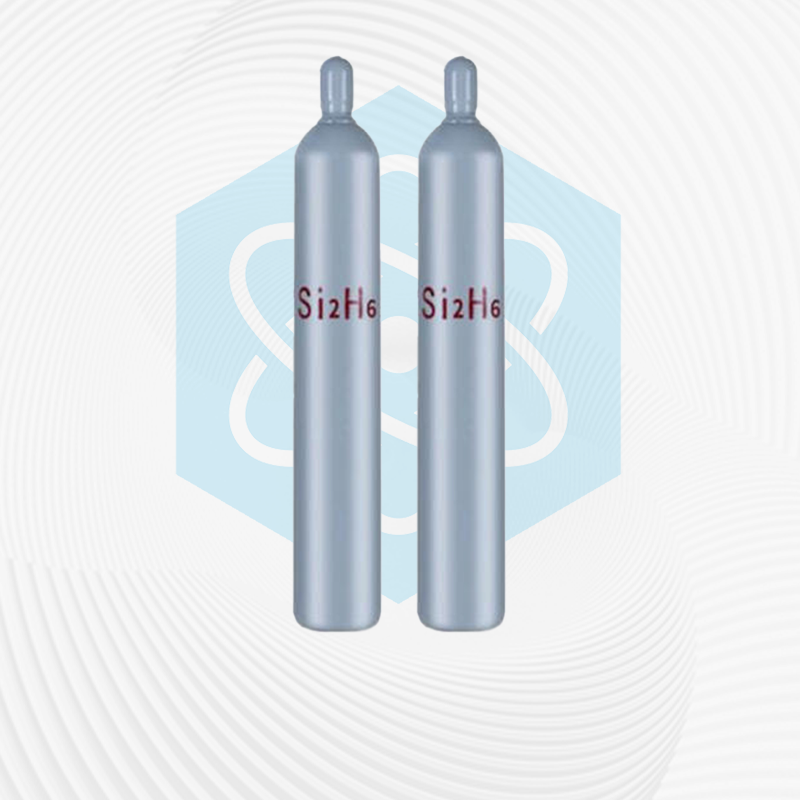Gasintroductie
Ethylsilane is een anorganische verbinding met de chemische formule Si2H6. Het is een kleurloos, transparant en giftig gas met een onaangename en irriterende geur bij kamertemperatuur en -druk. Het heeft chemische eigenschappen die vergelijkbaar zijn met silaan, maar de reactiviteit is sterker dan silaan. Het is instabieler dan silaan en ontleedt langzaam in silaan en waterstof bij kamertemperatuur. Ontleedt in SiH4, SinHm, H2 bij 300-500 ℃ en ontleedt ook onder licht. Wordt voornamelijk gebruikt in zonnecellen, lichtgevoelige roterende buizen, amorfe siliciumfilms, epitaxiale groei, oxidefilms, nitridefilms, chemische dampafzetting en andere aspecten.
Basis eigenschappen
Ethylsilane is een kleurloze transparante vloeistof die spontaan ontbrandt in de lucht, met een ontstekingspunt onder kamertemperatuur. Wanneer het in contact komt met lucht, verbrandt het onmiddellijk en ontleedt het in SiH4 en H2. Het verbrandingsconcentratiebereik is breed en wanneer de concentratie boven de 0,2% ligt, wordt er een vlam afgegeven tijdens de verbranding; wanneer de concentratie onder de 0,2% ligt, wordt er een oxidatiereactie uitgevoerd om witte SiO2 te genereren. Explosieve verbranding in chloorgas. Reageer explosief met halogeengassen, maar voer bij lage temperaturen halogenering matig uit. Bij contact met SF6 zal het exploderen. Intense reactie met koolstoftetrachloride en chloroform. Reageer en ontbind met alkalimetalen en kwiklegeringen om silaan en waterstof te produceren. Reageer met bijtende kalium om H2 vrij te maken. Het reageert niet met zuiver water en zuur, maar reageert met alkali om silicaten en waterstof te produceren. Zelfs de aanwezigheid van sporen alkali opgelost uit glas kan hydrolyse van ethaan veroorzaken. In aanwezigheid van KH- of LiCl-verontreinigingen ontleedt het langzaam bij kamertemperatuur.
Si2H6- → SiH4+(SiH2) x
Ethylsilane is oplosbaar in koolstofdisulfide, ethylalcohol, benzeen en ethylkiezelzuur. Het tast rubber, boter, smeermiddelen, lood, etc. aan, maar tast de meeste metalen niet aan.
Belangrijkste toepassingen
1. Gebruikt in zonnecellen, lichtgevoelige roterende buizen, amorfe siliciumfilms, epitaxiale groei, oxidefilms, nitridefilms, chemische dampdepositie en andere gebieden. Bij de productie van zonnecellen is de depositiesnelheid van ethyleensilaan op amorfe siliciumwafels veel sneller dan die van silaan en kan de temperatuur met 200-300 ℃ worden verlaagd. Bij ionenimplantatie is het gebruik van ethaan als ionenbron waarschijnlijker om te gloeien en heeft het een sterkere bundelstroom, wat resulteert in aanzienlijk betere resultaten dan het gebruik van andere gassen als ionenbronnen.
2. In de halfgeleidertechnologie wordt het gebruikt voor epitaxiale en diffusieprocessen, evenals voor lichtgevoelige trommels die worden gebruikt in zonnecellen en elektronische fotografie.




